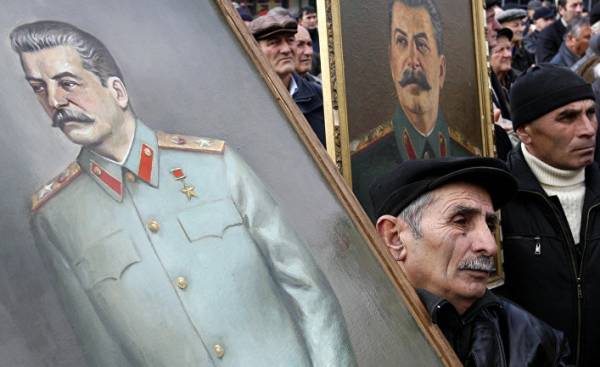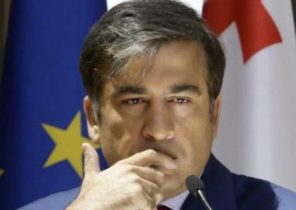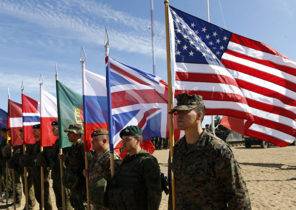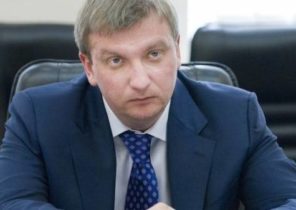
We present to your attention: at the right hand of Hitler’s Germany, on the left — the Soviet Union of Stalin. Chief judge — Richard Overy and his book “the Dictators”, without which our understanding of twentieth century history would be incomplete.
Hitler and Stalin are often cited in the major ideological disputes, flashing between left and right, as participants in a kind of macabre contest, which aims to determine which of them is more vile person who killed more people. Besides the fact that the mapping is in the highest degree disgusting to any conclusions, it also does not. However, the British historian Richard Overy (Richard Overy) in the book “the Dictators”, published in 2004 and is currently reprinted in Portugal by Bertrand publisher (the first edition came out in 2005) in a flawless translation of Victor Antonescu (Victor Antunes), has other purposes.
Overy is not going to make grim calculations, its purpose is to analyze similarities and differences in the modes of the two dictators. The author carefully notes that “to compare is not the same as to equalize”. Overy emphasizes that does not seek to make assumptions about what Hitler and Stalin “was characterized by the same type of person […] or that based on these two examples we can deduce the General characteristics of a dictator or dictatorship”.
British historian would subscribe to the words of the French writer Georges Bernanos from his essay “Large cemeteries under the moon”: “One Terror is like the other, one is the other, you can’t make me do the differences between them — now that I’ve seen a lot, learned a lot and me for many years. I always and everywhere disgusting fear, and for the beautiful words of the executioners is only he. Always destroy fear, hatred at the same time — an alibi…” (excerpt translated by V. G. Isakova — approx.TRANS.). These words of Bernanos deserve even more admiration, if we consider that they were written in 1938 under the impression from the civil war in Spain at a time when Nazi terror had not yet declared itself in full force, and nobody knew about the true scale and brutality of Soviet terror.
Normal people, or psychopaths?
According to Overy, Hitler and Stalin normal people were not, however, the author is also not inclined to attribute them to the mentally ill, and believes that they are completely responsible for their actions.
Both have moved “unconditional dedication, historical performers which they […] believed”. Partly common to both dictators, the obsession with death due to fear is not to live long enough to fulfill the mission entrusted to them.
A striking proof of the absolute conviction in his own destiny is the statement 1 April 1924, Hitler made a speech in his defence at the Munich court, where he was accused of instigating the so-called “Beer hall putsch”: “You a thousand times to consider us guilty, but the goddess of the eternal court of history will smile and throw the proposal of the state Prosecutor and the sentence of the court; we will be found innocent”. Overy does this in the book, but it seems quite appropriate to compare this statement with certainty what Stalin once expressed in a conversation with Molotov: “I know that after my death my grave will cause a bunch of garbage. But the wind of history cruelly dispel her.” Or, for that matter, with the phrase, which is October 16, 1953, Fidel Castro ended a four-hour speech in court, where he was accused of the attack on Moncada barracks “History will absolve me”.
Overy also points to other similarities of the personalities of Hitler and Stalin: both were typical of “ruthlessness, opportunism, variability in the choice of tactics and their political actions are the most forthright manner was aimed at personal survival. Both underestimated how supporters and opponents, not sozdavalsya that such a lowly and humble in the rest of the figure was hiding inside the bundle of ambitions, political violence and devoid of any morality, contempt for others”.
This neglect is heard in the words that Hitler spoke in the mid 30-ies in a personal conversation with his (temporary) ally of Nazi German Rushinga: “the Masses are like an animal that obeys its instincts. They are not able to come to any conclusion, the power of the mind […] With large clusters of mass thinking is abolished”. The same coldness and lack of empathy sounds attributed to Stalin the phrase that “human death is a tragedy, the death of millions — statistics”.
The image of the leader
Dictators differed from one another oratorical skills and the ability to hold the audience in the first years after the October revolution, Stalin was a figure of the unremarkable, apparently “modest and understated, without the glitz and confidence in their own intellectual superiority, as evidenced by many of his comrades. His contemporaries recall that his speech was “monotonous”, speech data is pretty mediocre, he slowly read a prepared text, making random pauses to catch your breath.”
Partly this manner was a cover-up, but the truth is that Stalin never was a convincing speaker in contrast to Hitler, who, during the 1920-ies “was able to turn their boring arguments in the public triumph of eloquence, who became his most important attribute.”
Although the image of Stalin on propaganda posters have been generous retouching, he hardly was so obsessed with his own way as Hitler, who “was terrified of appearing ridiculous” and ordered his personal photographer Heinrich Hoffmann to never remove his glasses or a bathing suit.
But the truth is that neither Hitler nor Stalin could not boast of impressive appearance: the proposed Overy portrait of Hitler in 1920-e years in “the legendary dirty trench-coat, dark tendrils falling on his forehead a strand of hair, pale and slightly plump face and blue-gray eyes, which sometimes seemed to be wandering and missing”, contrary to magnetic effect, which many — even those who did not sympathize with his ideas — the confessions felt in his presence.
Concentrating power in his hands, both of the dictator brought the personality cult to new extremes, while Overy said that the reasons for this in two cases was totally different. According to Hitler, “personality is a decisive criterion for leadership,” modern and efficient state should be based on her and not on the concept of majority; the implication was that “one of a kind genius [among which he certainly included himself] once to reflect on ordinary humanity.”
Stalin arises in the context of a revolution whose goal was the replacement of personal leadership, embodied in the figure of the king, the party of the masses, but pretty soon, Stalin recognized that in times of crisis it becomes necessary “to concentrate all the forces of the proletariat in one single point”. From the requirement of a single party line to establish authoritarian leader was only one step — “people need a star,” he admitted later.
There is evidence that Stalin displayed a resistance formed around his personality cult, but in fact. although the Soviet leader and had absolute power, he did nothing to abolish or even mitigate the cult of what it was like, either due to the fact that he was aware of its usefulness in the management of a country and subjugation of the masses, or because, according to Overy, in the national autocracies, “the Governor, acting in the image of the mythical hero, and his followers that make him a Saint and put in it the content of” become sort of accomplices resulting in “dictators, it is extremely difficult to get out of the play, which they themselves helped to organize”.
The cult leader
The extent of the cult that has developed around the two leaders, so great that now seem, frankly, ridiculously absurd. As example, has Stalin official titles: “the Great Builder of communism”, the “genius of humanity”, “coryphaeus of science” and “gardener of human happiness” — and educated in his name the names of cities: Stalingrad, Stalinogorsk, Stalinabad, Stalingrad, Staliniri and Stalino. In 1935, in Pravda published a speech by Alexander Avdeenko (a juvenile offender, of which communism and hard work made a worker and then a writer specializing in the praise of the regime), which did not stint on hyperbole: “All generations will call your name, strong, beautiful, wise, amazing. Your name is engraved on every factory, every machine, every corner of the earth, in every human heart”. Sometimes Stalin extolled, and to the truth of divine spheres, as, for example, this published in 1936 in “Truth” the Eulogy: “O you, the great leader of the people, / have Called for human life, / who Called the land to fertility”.
If Soviet writers else can understand, because such kind of eulogies ensured the favor of the regime, and ultimately survival, it is no less crazy by nature praise foreign intellectuals who visited the Soviet Union, lead to confusion. Take, for example, an excerpt from the essay “peace to the World: the Soviet Union and the people’s democracy”, written by Jorge Amado after he, at the invitation of the Soviet writers ‘ Union held in the Soviet Union the winter of 1948-1949 year: “[Stalin] wise leader of the peoples of the world in the struggle for the happiness of man on earth. […] His name to the owners of the factories — the eagle scream, for ordinary workers — the sweet chirping of birds. The scope of its identity beyond the borders of the USSR, Stalin everywhere, where man is fighting against oppression and suffering […] We love in Stalin’s Soviet Union, following the path of communism. We love in Stalin’s culture, the youth, the beauty of things, harmony and music. For us it is a symbol of this and more. Stalin with the common people, the oppressed workers, with those who seek freedom, who is fighting who builds a new life. Ordinary people all over the world, working look in the face of this man, who works in the Kremlin, and welcome in the beauty of life, the joy of creation, won freedom, the brotherhood of man”.
Stalin was awarded many awards and titles. Rejected it only two sentences, seemed to him unnecessary renaming of Moscow Stalinodar (“the gift to Stalin”) and the idea to start the calendar with the birthday of the leader. The newspaper “Izvestia”, which was a kind of mouthpiece of the Communist party, in August 1936, recognized that “writers do not know with whom to compare you, our poets no longer worthy gems of language to adequately describe you.”
Let the “not so exaggerated and naive as the cult of Stalin in the USSR”, in Germany we see a similar excitement around the personality of Hitler, which is one of the leaders of the Nazi party compares with the “new Jesus Christ, a greater and stronger”, a Minister of the Church sees it as “the true Holy Ghost,” Robert Ley (head of German labor front) said that “Adolf Hitler was sent to us by the Lord himself,” and Rudolf Hess (right hand of Hitler), to paraphrase the Bible (Isaiah 9:6), argues, “us a child is born in Braunau” (Braunau am Inn, the hometown of Hitler), “”little altars” dedicated to Hitler, [began to appear] in public places and private homes,” and the book Mein Kampf was considered (according to the program Pro-Nazi Christian movement) “the greatest monument of literature of our people” and repository “of the most pure and genuine ethical values.”
Timely appearance in times of crisis
According to Overy, “neither of the two heroes of his book couldn’t just pick up and usurp power. [Their] dictatorship was the result of a unique historical situation which is perfectly fit not only the ambitions of the leaders themselves, but also the aspirations of those whose interests they are intended to represent.”
In the case of Hitler we can talk about “extreme political and social crisis caused by the depression of 1929, [it] resulted in a nationalist revolution that challenged the whole political system, culture and values of the Republic and longed for a genuine national community of Germany.” In the case of Stalin we are talking about a “second revolution” that began in 1928, about the “extraordinary period of social unrest in connection with the beginning of collectivization, the five-year plans and the ongoing attack on the culture, ideas and knowledge, defined as “bourgeois””. It is in this context, Hitler and Stalin acted “as representatives of all those who strive for change and stability. If not for the crisis, it would be hard to believe that someone from these two politicians could rise to the position of dictator.”
Overy draws attention to the fact that the Messianic cult that has developed around Hitler, was not “a feature of German political culture, its appeal was derived from a General, although not unanimous, the expectation of a German Redeemer.”
In turn Stalin after Lenin’s death, has made a skilful manoeuvres, in order to appear in the eyes of the people “by the only genuine revolutionary theory.” To this end, in 1924, Stalin publishes “the Foundations of Leninism” (the Leninist leadership for the uninitiated) and in the political struggle, which was conducted during the 1920-ies, is doing everything possible to establish itself as the only legitimate interpreter of Leninism and to hide the evidence of discontent and suspicion that Lenin showed towards his person. The address of Bukharin and his supporters, he made the following accusation: “All your company are not Marxists, and healers. None of you understand Lenin.” As a result, in 1929, Bukharin was removed from office, he has worked in the Comintern and “Truth”; in November of the same year, was also expelled from the Politburo and in December, “Truth” has already praises Stalin as “first disciple of Lenin.” Even if these outstanding qualities were true, it remains to be seen what practical application may have a political ideology so abstruse that only one person on the planet can understand it.
Views on democracy
Being on the opposite political poles, Hitler and Stalin, however, had somewhat similar views on democracy. Stalin in 1936, stated that “in capitalist countries […] the ultimate democracy of the powerful, democracy for the minority who hold wealth […] the Soviet people only need the party because of disagreements between capitalists and workers or between landowners and peasants no longer exists.” A few months later, Hitler explained at a meeting of Nazi leaders that “first of all we can not tolerate opposition, because it will certainly lead to a new fragmentation”. Both dictators, Overy writes, “took a multi-party system as a manifestation of social unrest and divided loyalty, and not as a freely made political choice.”
“Each of the modes has positioned itself as the choice of the people, whose interests he represented and negotiated” (Overy). Representation of interests of the Soviet people were provided with the Communist party and the government, as in Germany, “democracy meant nothing more than a government of the people for the people” (to use the expression of one of the Nazi jurist). In his speech in 1937 Hitler posed the rhetorical question: “What could be more beautiful for the people the realization that from within their ranks, regardless of origin, pedigree or anything else, come out better people who are able to reach the greatest heights?”
These claim to “socialist democracy” and “democracy on the German model,” which allegedly “[represent] all the people as not able to make liberal parliamentary system”, today, reflected in populist movements, which in recent years are gaining momentum in Europe and North America and claim a more direct link with the people without the mediation of the political class, which they portrayed as mired in corruption and acting in someone’s outside interests.
Regarding the methods used in the political struggle, here, both the dictator demonstrate extraordinary similarities: learning about the Night of the long knives (when in June 1934, Hitler organized a merciless purge of the SA and ordered the execution of its leader, Ernst Rohm), Stalin exclaimed: “Hitler, what good! Here’s how to deal with political opponents”.
Life under terror
When discussing the history of Nazism and Stalinism often arises this question: why did the Germans and the Soviet people without any hesitation or resistance adopted the construction of the repressive machine that received so pervasive and ruthless character?
Overy says that “both the regime positioned the state security apparatus as a tool to protect the majority of the population that is not involved in subversive activities.” And people were the more ready to adopt such a defense, the more serious they perceived to be a threat — besides, in both countries worked effectively propaganda machine that inspired the German people the idea of the existence of a large and sinister Jewish-Bolshevik conspiracy, and in the minds of the Soviet people have internalized the idea that powerful reactionary forces, in collusion with foreign powers and international capitalism, all the while striving to undermine the power of the Soviet Union. Thus, according to the “official” version, both, “fought tirelessly against Subversion and decline of national life. It’s a deadly and ruthless war was waged on behalf of the people. Terror as a system, was representative”.
However, between the oppressive systems of Germany and the USSR, there are significant differences. “Despite its obvious unfairness and incompetence, the legal conventionality and artificiality, the Soviet system worked on legally recognized”. That is, the investigation could be biased and corrupt, and sentencing was a farce, but the regime considered it his duty to investigate and try cases in court. Even during the most fierce repression “of the state security service had no right to detain people and put them in jail or execute them without prior interrogation or sentencing.” Meanwhile in Germany, repression was carried out illegally — adopted in 1936 “the new law freed from the Gestapo any intervention of courts, giving it the authority to decide who is a political offender and what constitutes a political offence”.
Of course, the appearance of justice does not soften the brutality of the security apparatus, and the bullet fired into the back of the head by the decision of the courts that are remotely related to the law, does not bring more solace to the innocent victim than if she was executed without trial.
The main difference
Despite the fact that in both cases, the victims of the regime were millions that were created by the repressive and murderous apparatus of the state security organs, and a number of other similarities in various fields Richard Overy focuses on the significant difference, at least from the point of view of formal goals: “Soviet communism’s aim is the progress of humanity, as imperfect as this concept may seem to us today, while national socialism was inherently a tool for the progress of one particular of the people” and sought “to build a new European order based on racial hierarchy and cultural superiority of the German Europe”.
On the other hand, we can say that Soviet communism was of a more insidious nature: while Hitler from the very beginning of his political career (or at least since the publication of Mein Kampf) openly talked about his sinister projects of the Stalinist regime, in pursuit of repression and organizing the GULAG, at the same time hypocritically promised “future prosperity” and did glorify the great achievements and the progress of civilization of the country — so much so that he managed to persuade many foreign Communists that the Soviet Union is implementing a Grand utopia.
The results
The book “the Dictators” offers the reader a comprehensive comparative analysis of Nazi and Stalinist regimes, based on painstaking research work, and represents a fundamental work for understanding the nature of both regimes. Reservations only deserve two points.
1) the Story of the young Hitler in Vienna contains inaccuracies and omissions in the fragment, where it is stated that “contrary to what he said later [Hitler] lived in poverty since received a decent inheritance, and also sold his paintings, mostly landscapes, which were exhibited in local galleries”. Hitler really was supposed heritage, he also received some money from relatives (especially aunt Johanna), but all quickly squandered, because all the time went without work. Being without money, Hitler with the help of his quirky friend began to paint watercolors, many of which were copies of images for calendars and postcards. It was an unremarkable work, done mostly in haste and mediocre, based on the undemanding buyers. In the art world, these paintings were not recognized as “art” in the galleries was not present. Money raised from the sale of these watercolors, was clearly not enough to prevent the poor financial position of Hitler, who came to that was living in a homeless shelter — Hitler actually lived in poverty, although it was in this position mainly through their own fault.
2) Speaking about the German invasion of the USSR in 1941, Overy presents Stalin as if he never lost control of the situation, although, of course, the invasion itself, a distinct and numerous signs which he persistently and categorically denied, surprised him. Overy writes that “today we have evidence that Stalin worked all the time” in the early days unstoppable German offensive, operation Barbarossa and the successive defeats of the red Army, and did not break under the pressure of events. This was true until June 29 when, according to an authoritative biography of Stalin authored by Robert Service, the Soviet leader began to show unstable behavior. Stalin was confused, when Timoshenko and Zhukov reported to him about the true scale of shame of the Soviet troops; he disappeared on the “near dacha,” but instructed the staff never to tell; as time went on, and the top of the Soviet government, accustomed for any reason to receive orders of Stalin, was commotion. When his subordinates got up enough courage to go from his residence, they found Stalin’s tired, sitting in a chair; his first reaction was the question “why are you here?”, what made one of the members “of the delegation,” Mikoyan to assume that Stalin thought they had come to arrest him and to impeach him; he was worth some effort to understand what he was asked to head the State Defense Committee and Stalin returned to his usual demeanor and mood.
These reservations relate to the biographical details and do not affect the analysis and observations made Overy on the nature of the two regimes and personalities of their leaders. The main omission of this edition of the book is related to another: the Portuguese editor decided to cut the thirty index, which is always inexcusable, especially in the case of such an extensive work, comprising nearly 800 pages of text (more than 150 pages of notes and bibliography) that mentions hundreds of historical figures, organizations and institutions.







